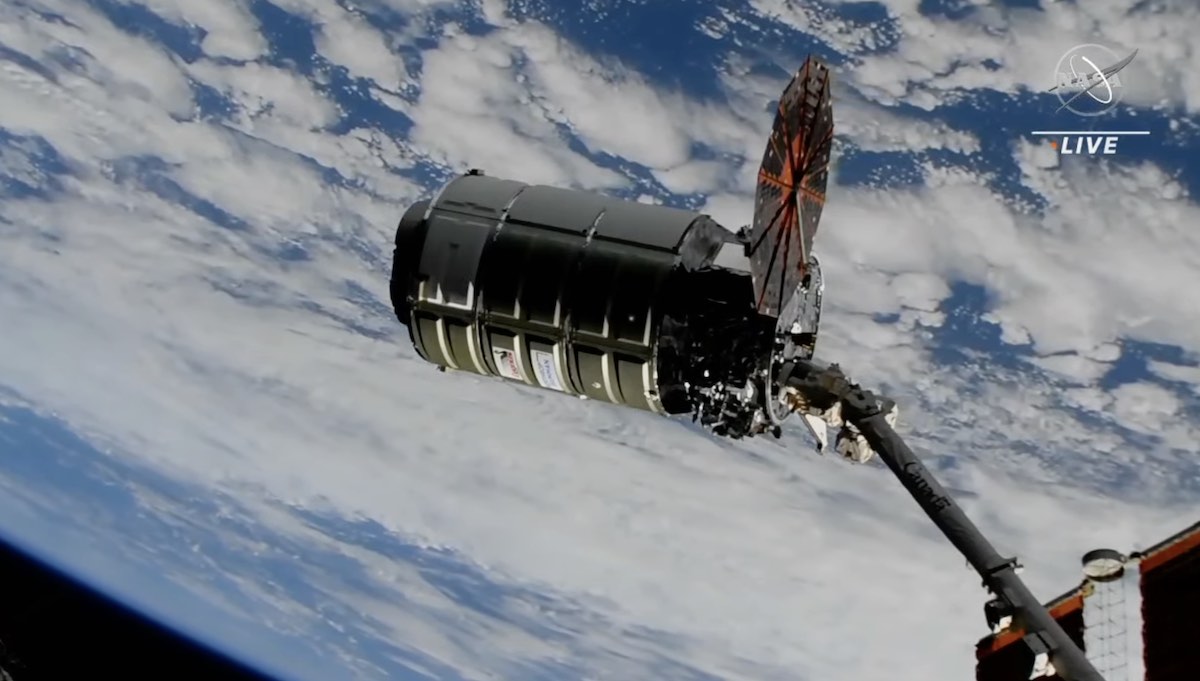
A Northrop Grumman Cygnus supply ship arrived at the International Space Station Wednesday, overcoming a deployment failure on one of its two power-generating solar arrays to deliver 4.1 tons of cargo and experiments to the complex.
The Cygnus spacecraft, nicknamed the “S.S.” Sally Ride after the first U.S. woman to fly in space, was captured by the station’s Canadian-built robotic arm at 5:20 a.m. EST (1020 GMT) Wednesday as the complex sailed more than 250 miles over the Indian Ocean. NASA astronaut Nicole Mann controlled the robotic arm for the capture of the Cygnus supply ship.
The mission, designated NG-18, marked the 18th arrival of a Cygnus supply ship at the space station since 2013. Northrop Grumman has a multibillion-dollar cargo transportation contract with NASA to ferry supplies to the space station, alongside NASA’s other incumbent supply ship operator SpaceX.
“Huge congratulations to the NG-18 team for their tireless efforts getting ‘Sally Ride’ to the ISS and for a successful capture today,” Mann radioed mission control from her operating post on the space station.
Ground controllers planned to take over commanding of the robotic arm later Wednesday morning to position the Cygnus spacecraft on an Earth-facing berthing port on the space station’s Unity module. Once the Cygnus spacecraft is firmly bolted to the Unity module, astronauts on the station will open hatches to begin unpacking some 8,265 pounds (3,749 kilograms) of cargo inside its Italian-made pressurized cabin.
The Cygnus supply ship launched Monday from Wallops Island, Virginia, aboard an Antares rocket. But Northrop Grumman engineers determined the supply ship only deployed one of its two fan-shaped solar arrays after deploying from the rocket in orbit.
Northrop Grumman and NASA engineers determined the Cygnus spacecraft had sufficient power to rendezvous with the space station Wednesday.
“To remain focused on the spacecraft’s arrival at the station, Northrop Grumman and NASA made the determination not to deploy the second solar array after initial attempts to deploy it were unsuccessful,” NASA said in a statement Tuesday. “The Cygnus team is gathering information on why the second array did not deploy as planned.”
Inspections of the spacecraft were planned during its rendezvous with the space station Wednesday, and after its arrival at the complex.
The Cygnus spacecraft uses UltraFlex solar arrays built by Northrop Grumman that are designed to open up in a rotational fan-like motion. The solar array material is stowed against the body of the Cygnus spacecraft for launch, then a mounting arm is supposed to deploy before the command to begin opening the solar array.
Imagery from the space station’s cameras Wednesday appeared to show one of the two fan-shaped solar arrays fully unfurled. The other solar array appeared to have its mounting bracket deployed, but the solar array did not take the next step in deployment to stretch out the material with the power-generating solar cells.
The Cygnus supply ship for the NG-18 mission was packed just 1 pound shy of the mission’s total carrying capacity.
“We really topped it off,” said Steve Krein, vice president of civil and commercial space at Northrop Grumman. “And also we’re maximizing the fuel load to really allow for contingencies as required, and also for operational maneuvers on station to support our mission should the customer choose to exercise that.”
The Cygnus spacecraft will use its main engine to reboost the orbit of the space station while it is attached to the complex.
“Cygnus is carrying some important spacewalk hardware,” said Jeff Arend, NASA’s manager of systems engineering and integration for the International Space Station program. “One critical set of hardware is what we call a ‘mod kit,’ which is a collection of brackets that the crew will install outside while on the spacewalk that’s currently planned for Nov. 15.
“The crew will partially assemble it inside, and then they will take it through the airlock and install it at the base of a solar array wing so that it can be a support structure for a future set of roll out solar arrays,” Arend said.
“Cygnus will be bringing up some food treats for the crew,” he said. Those include peanut butter, olives, cheeses, pumpkin spice cappuccino, apples, blueberries, oranges, and chocolate and vanilla ice cream.
The mission will also deliver to the space station a 3D bioprinter to conduct research in human tissue printing, a plant growth experiment, and technology demonstrations.
The space station crew and support teams on the ground are gearing up for a busy few weeks ahead, with the arrival of Northrop Grumman’s Cygnus spacecraft set for Wednesday, followed by the launch and docking of a SpaceX Dragon cargo ship later this month.
There are also seven spacewalks planned before the end of the year outside the space station — three outside the U.S. segment using NASA spacesuits, and four Russian excursions.
At the end of the mission, the Cygnus spacecraft will depart the station in January and head for a destructive re-entry into the atmosphere over the Pacific Ocean with several tons of trash.
Email the author.
Follow Stephen Clark on Twitter: @StephenClark1.
from Spaceflight Now https://ift.tt/s6xCdOA
via World Space Info







0 comments:
Post a Comment